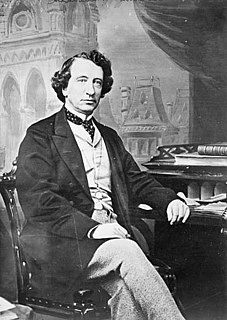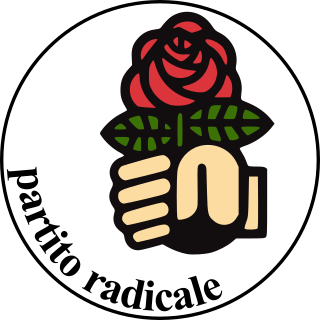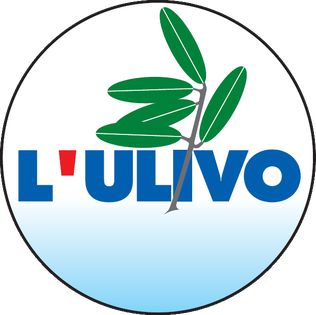
Christian Democracy was a Christian democratic political party in Italy. The DC was founded on 15 December 1943 in the Italian Social Republic as the ideal successor of the Italian People's Party, which had the same symbol, a crusader shield. As a Catholic-inspired, centrist, catch-all party comprising both centre-right and centre-left political factions, the DC played a dominant role in the politics of Italy for fifty years, and had been part of the government from soon after its inception until its final demise on 16 January 1994 amid the Tangentopoli scandals. Christian Democrats led the Italian government continuously from 1946 until 1981. The party was nicknamed the "White Whale" due to its huge organization and official color. During its time in government, the Italian Communist Party was the largest opposition party.

The 1872 United States presidential election was the 22nd quadrennial presidential election, held on Tuesday, November 5, 1872. Despite a split in the Republican Party, incumbent President Ulysses S. Grant defeated Democratic-endorsed Liberal Republican nominee Horace Greeley.

Forza Italia was a centre-right political party in Italy with liberal-conservative, Christian-democratic, liberal, social-democratic and populist tendencies. Its leader was Silvio Berlusconi, who served as Prime Minister of Italy four times.

The Democrats of the Left was a social-democratic political party in Italy.

The 1867 Canadian federal election was held from August 7 to September 20, 1867, and was the first election for the new country of Canada. It was held to elect members representing electoral districts in the provinces of Nova Scotia, New Brunswick, Ontario and Quebec to the House of Commons of the 1st Canadian Parliament. The provinces of Manitoba (1870) and British Columbia (1871) were created during the term of the 1st Parliament of Canada and were not part of this election.

The Radical Party was a liberal and libertarian political party in Italy. For decades, the Radical Party was a bastion of anti-clericalism, civil libertarianism, feminism, liberalism and radicalism in Italy as well as environmentalism. The party proposed itself as the strongest opposition to the Italian political establishment, seen as corrupt and conservative. Although it never reached high shares of vote and never participated in government, the party had close relations with the other parties of the Italian left—from the Republicans and the Socialists to the Communists and Proletarian Democracy—and opened its ranks also to members of other parties through dual membership.

The Olive Tree was a denomination used for several successive centre-left political and electoral alliances of Italian political parties from 1995 to 2007.

The 1949 Canadian federal election was held June 27, 1949 to elect members of the House of Commons of Canada of the 21st Parliament of Canada.

The 1953 Canadian federal election was held on August 10, 1953 to elect members of the House of Commons of Canada of the 22nd Parliament of Canada. Prime Minister Louis St. Laurent led his Liberal Party of Canada to its second consecutive majority government, although the party lost seats to the other parties.

The 1958 Canadian federal election was held to elect members of the House of Commons of Canada of the 24th Parliament of Canada on March 31, 1958, just nine months after the 23rd election. It transformed Prime Minister John Diefenbaker's minority into the largest majority government in Canadian history and the second largest percentage of the popular vote. Although the Tories would surpass their 1958 seat total in the 1984 election, the 1958 result remains unmatched both in terms of percentage of seats (78.5%) and the size of the Government majority over all opposition parties. Voter turnout was 79.4%.

The 1962 Canadian federal election was held on June 18, 1962, to elect members of the House of Commons of Canada of the 25th Parliament of Canada. The governing Progressive Conservative (PC) Party won a plurality of seats in this election, and its majority government was reduced to a minority government.

Democracy is Freedom – The Daisy, commonly known simply as The Daisy, was a centrist political party in Italy. The party was formed from the merger of three parties within the centre-left coalition: the Italian People's Party, The Democrats and Italian Renewal. The party president and leader was Francesco Rutelli, former mayor of Rome and prime ministerial candidate during the 2001 general election for The Olive Tree coalition, within which The Daisy electoral list won 14.5% of the national vote.

The Italian Republican Party is a liberal and social-liberal political party in Italy. Founded in 1895, the PRI is the oldest political party still active in Italy.

The Democratic Alliance was a social-liberal political party in Italy.

The Italian People's Party was a Christian-democratic, centrist and Christian-leftist political party in Italy. The party was a member of the European People's Party (EPP).

The Italian Democratic Socialist Party, also known as Italian Social Democratic Party, was a minor social-democratic political party in Italy. The longest serving partner in government for Christian Democracy, the PSDI had been an important force in Italian politics, before the 1990s decline in votes and members. The party's founder and longstanding leader was Giuseppe Saragat, who served as President of the Italian Republic from 1964 to 1971.

The Segni Pact, officially called Pact of National Rebirth, was a Christian-democratic, centrist and liberal political party in Italy. The party was founded and named after Mario Segni, a former member of the Christian Democrats who was a prominent promoter of referendums.

Liberal Party is a conservative-liberal political party in Moldova. The president of the party is the former Mayor of Chișinău, Dorin Chirtoacă.

Popular Unity was a short-lived social-democratic and social-liberal and political party in Italy. Its leaders were Piero Calamandrei, a Democratic Socialist, and Ferruccio Parri, a Republican and former Prime Minister.

The Italian Social Movement, later renamed the Italian Social Movement – National Right, was a neo-fascist political party in Italy. A far-right party, it presented itself until the 1990s as the defender of Italian fascism's legacy, and later moved towards national conservatism.


















